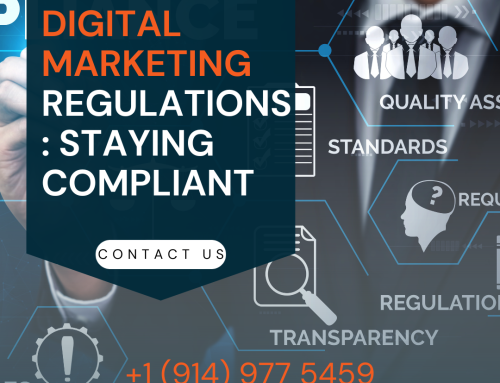Before we dive into the metrics and analytics, let's establish a foundation. The digital marketing ecosystem is a complex web of strategies and channels, from social media to email marketing and SEO. Your success depends on effectively weaving these elements together, and analytics is the compass that guides your way.
Share This Story, Choose Your Platform!
In this dynamic digital landscape, active coordination among various marketing channels is essential. Each channel has its unique strengths, and an active approach to integration can yield powerful results. For instance, social media campaigns can complement your email marketing efforts, while SEO strategies can enhance the visibility of your blog content.
The key to success here is not only understanding the role of each channel but also actively orchestrating them to work together seamlessly. This way, you can create a unified and compelling brand experience for your audience, maximizing the impact of your digital marketing endeavors.
Website Traffic and User Behavior
Website traffic is the heartbeat of digital marketing. Active monitoring of visitor numbers, session durations, and bounce rates provides insights into how users engage with your site. Analytics tools like Google Analytics track these metrics, helping you optimize your site’s structure and content for a seamless user experience.
Understanding user behavior through active data analysis is crucial. By examining which pages attract the most visitors, where users tend to drop off, and what paths they follow, you can actively fine-tune your website to guide users toward desired actions, whether it’s making a purchase, signing up for a newsletter, or engaging with your content.
Active efforts to reduce bounce rates and increase time spent on your site can significantly impact conversion rates. User behavior metrics, when actively harnessed, provide actionable insights that allow you to continually refine your website for maximum digital marketing success.
Conversion Rate Optimization (CRO)
The ultimate goal of eCommerce digital marketing is conversions, whether it’s making a purchase, signing up for a newsletter, or downloading an eBook. CRO measures the effectiveness of your efforts in turning visitors into customers. By actively analyzing conversion rates and experimenting with changes to your website, you can continuously refine your strategy for maximum success.
Active CRO is an ongoing process of experimentation and optimization. It involves split testing different versions of landing pages, call-to-action buttons, and even ad copy to actively identify what resonates most with your audience. It’s not a one-size-fits-all approach; instead, it’s about actively tailoring your website to meet the unique needs and preferences of your visitors, actively boosting conversion rates and eCommerce digital marketing success.
Click-Through Rate (CTR)
CTR is a vital metric for assessing the performance of your ads and email campaigns. It measures the percentage of users who click on a specific link. Active A/B testing, crafting compelling call-to-action buttons, and optimizing ad copy are essential tactics for improving CTR and driving more traffic to your desired destination.
Active management of CTR begins with understanding your target audience and tailoring your messaging to their needs and preferences. A/B testing allows you to actively experiment with different ad variations to identify what actively resonates with your audience. By continuously monitoring and actively optimizing your CTR, you can boost the effectiveness of your digital marketing campaigns.
Return on Investment (ROI)
ROI is the holy grail of digital marketing success. It quantifies the revenue generated from your marketing efforts compared to the costs incurred. Active tracking of ROI across different channels and campaigns allows you to allocate your budget effectively and invest more in strategies that deliver the highest returns.
Active ROI analysis involves tracking revenue generated from specific campaigns or channels and comparing it to the associated costs. It’s essential to actively monitor this metric to ensure that your digital marketing efforts are delivering a positive return. By actively optimizing your campaigns based on ROI insights, you can allocate resources efficiently and drive greater profitability.
eMail Marketing Metrics
eMail marketing remains a potent tool, but its success hinges on understanding metrics like open rates, click rates, and unsubscribe rates. Active segmentation of your email lists and crafting personalized content can boost these metrics, enhancing your email marketing effectiveness.
Active email marketing metrics analysis allows you to gauge the health of your email campaigns. Open rates indicate the effectiveness of your subject lines, while click rates highlight the relevance of your content. Active A/B testing of different email elements and segments ensures that you’re actively optimizing your email marketing strategy for maximum engagement.
Social Media Engagement
Social media is a dynamic landscape. Active monitoring of engagement metrics like likes, shares, and comments helps gauge the resonance of your content with your audience. Experimenting with different content types and posting schedules can drive higher engagement rates.
Active social media engagement analysis enables you to actively tailor your content strategy. It’s not just about accumulating likes and shares but actively understanding what type of content resonates with your audience. By actively responding to comments and fostering conversations, you can build an engaged online community that actively contributes to your digital marketing success.
Customer Acquisition Cost (CAC)
CAC measures the cost associated with acquiring a new customer through marketing efforts. Active optimization of your marketing campaigns and channels can help reduce CAC, making your eCommerce digital marketing strategy more cost-effective in the long run.
Active CAC analysis involves tracking the expenses related to specific marketing campaigns or channels and dividing it by the number of new customers acquired. Lowering CAC requires active measures such as improving ad targeting, optimizing landing pages, and enhancing the overall efficiency of your marketing campaigns.
Customer Lifetime Value (CLV)
CLV assesses the long-term value a customer brings to your business. Active nurturing of customer relationships through loyalty programs and personalized offers can boost CLV, which is a critical metric for eCommerce businesses aiming for sustained growth.
Active CLV analysis allows you to understand the potential lifetime revenue generated from a single customer. By actively segmenting your customer base and actively targeting high CLV segments with tailored marketing efforts, you can actively maximize your eCommerce digital marketing success.
Data-Driven Decision Making
In the world of eCommerce digital marketing, active data analysis and informed decision-making are paramount. The metrics and analytics discussed in this guide empower you to make strategic choices that maximize success. By actively monitoring and adapting your strategies based on these insights, you can continually refine your approach and achieve digital marketing success that drives growth and ROI.
Conclusion
Congratulations, you’ve unlocked the secrets to eCommerce digital marketing success through metrics and analytics. Armed with these tools, you’re ready to navigate the digital marketing ecosystem actively. Remember, it’s not just about the data; it’s about how you actively use it to drive your business forward. By analyzing, optimizing, and adapting, you’ll set yourself on the path to sustained eCommerce digital marketing success.
Elevate your eCommerce game with Purple Cow‘s data-driven approach to digital marketing. Our expert team deciphers key metrics and analytics, guiding you to success. Uncover the power of informed decisions that drive growth, engagement, and ROI. Let us be your compass to digital marketing mastery!
Share This Story, Choose Your Platform!
In This Blog:

















